水文学原理英文版
- 格式:ppt
- 大小:2.37 MB
- 文档页数:5
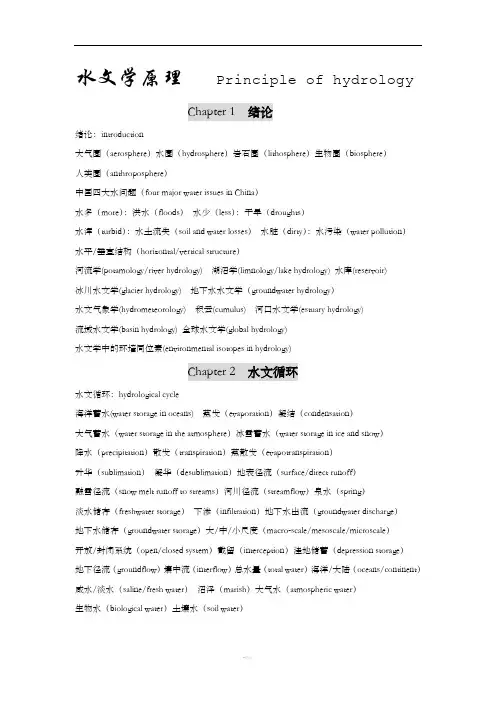
水文学原理Principle of hydrologyChapter 1 绪论绪论:introduction大气圈(aerosphere)水圈(hydrosphere)岩石圈(lithosphere)生物圈(biosphere)人类圈(anthroposphere)中国四大水问题(four major water issues in China)水多(more):洪水(floods)水少(less):干旱(droughts)水浑(turbid):水土流失(soil and water losses)水脏(dirty):水污染(water pollution)水平/垂直结构(horizontal/vertical structure)河流学(potamology/river hydrology) 湖沼学(limnology/lake hydrology) 水库(reservoir)冰川水文学(glacier hydrology) 地下水水文学(groundwater hydrology)水文气象学(hydrometeorology) 积云(cumulus) 河口水文学(estuary hydrology)流域水文学(basin hydrology) 全球水文学(global hydrology)水文学中的环境同位素(environmental isotopes in hydrology)Chapter 2 水文循环水文循环:hydrological cycle海洋蓄水(water storage in oceans) 蒸发(evaporation)凝结(condensation)大气蓄水(water storage in the atmosphere)冰雪蓄水(water storage in ice and snow)降水(precipitation)散发(transpiration)蒸散发(evapotranspiration)升华(sublimation)凝华(desublimation)地表径流(surface/direct runoff)融雪径流(snow melt runoff to streams)河川径流(streamflow)泉水(spring)淡水储存(freshwater storage)下渗(infiltration)地下水出流(groundwater discharge)地下水储存(groundwater storage)大/中/小尺度(macro-scale/mesoscale/microscale)开放/封闭系统(open/closed system)截留(interception)洼地储蓄(depression storage)地下径流(groundflow)壤中流(interflow)总水量(total water)海洋/大陆(oceans/continent)咸水/淡水(saline/fresh water)沼泽(marish)大气水(atmospheric water)生物水(biological water)土壤水(soil water)Chapter 3 流域与水系流域与水系:Watershed & Drainage NetworksPart 1 基本概念分水线(watershed divide) 闭合流域(closed watershed)非闭合流域(unclosed watershed) 水系(Drainage Networks)羽毛状水系(Elongated shape) 平行状水系(fan shape)混合状水系(mixed shape) 坡地(Slope) 倾斜面(inclined plane)收敛曲面(Convergent Camber) 发散曲面(Divergent Camber流域基本单元(Unit)P art 2 水系的地貌特征河源(headwater) 节点(node) 出口(outlet)外链(External links) 内链(Internal links) 干流(main river)支流(tributary river) Strahler分级法河流长度(stream length)河数定律(the law of stream numbers) 河长定律(the law of stream lengths)链长度(Link Length) 横断面(Cross section) 纵断面(longitudinal section)大断面(flood cross-section) 弯曲率(Sinuosity)河底比降(Slope of stream bed)Part 3 流域的地貌特征流域形状(Shape of watershed)流域坡度(Slope of watershed)流域面积及面积定律(Drainage area and the law of drainage areas)流域长度和宽度(Width and length of watershed)形态因子(Shape factor)圆度(Circularity ratio) 伸长比(Elongation ratio)河网密度和河道维持常数(Drainage density & constant of channel maintenance)河流频度和链频度(Stream frequency & link frequency)面积--河长曲线(Drainage area-stream length curve )高程曲线(Elevation curve)Chapter 4 降水降水(Precipitation)Part 1 降水要素及其时空变化表示方法(Precipitation elements & Temporal and spatial variation)降雨的基本要素(Rainfall Elements)降雨量(深) Rainfall (depth)降雨历时(Rainfall duration) 降雨强度(Rainfall intensity)降雨面积(Rainfall area) 暴雨中心(Storm center)降雨强度与历时曲线(Rainfall intensity-duration curve)降雨深与面积关系曲线(Rainfall depth-area curve)降雨深与面积和历时关系曲线(Rainfall depth-area-duration curve)Part 2 降雨类型及其影响因素(Types of rainfall and Affecting factors)气旋雨(Cyclonic rain) 对流雨(Convectional/Convective rain)台风雨(Typhoons/Hurricanes) 地形雨(Orographic rain)锋面雨(Frontal rain) 非锋面雨(Non-frontal rain)Part 3 区域(流域)平均降雨量计算方法(Calculation method of Average rainfall over an area)算术平均法(Arithmetic mean method) 泰森多边形法(Thiessen polygon method)等雨量线法(Isohyetal method) 距离平方倒数法(Inverse distance-squared method)雷达测雨(Radar measurement of rainfall) 卫星测雨(Satellitic measurement of rainfall) Part4 降雨资料的检验(Test of rainfall data)Chapter 5 土壤水土壤水(Soil Water)水文循环(Hydrologic Cycle)土壤颗粒(soil particles)过滤(leach)蒸发(evaporation)蒸发,散发(transpiration)水分(moisture)Part 1土壤的质地结构及“三相”关系土壤质地(Soil texture) 粘粒(clay)粉粒(silt)砂粒(sand)土壤结构(Soil configuration) 土壤中的“三相”关系(Three phases within a soil)固体(Solids)液体(Liquids)空气(Vapor)固体密度(solid density) 干容重(Dry bulk density) 孔隙度(Porosity)质量含水率(Gravimetric water content) 容积含水率(volumetric water content)饱和度(the degree of saturation) 充气孔隙度(Aeration porosity)孔隙比(Void ratio)Part 2土壤水的存在形态土壤水作用力(Forces governing soil water) 分子力(Molecular force)毛管力(Capillary force) 粘着力(Adhesion)粘结力(Cohesion)重力(Gravitational force) 土壤水类型(Soil water classification)束缚水(bound water)吸湿水(Hygroscopic Water) 膜状水(Film water)毛管上升水(Ascending water in capillary tube) 渗透重力水(percolating water)毛管悬着水(Suspended capillary water) sustained gravitational water(支持重力水) 土壤水分常数(Soil water constants) 田间持水量(field capacity)Saturation(饱和状态)Part 3土壤水的能量状态土水势(Soil water potential) 影响因素(Affect the factors)土壤水分特性曲线(Soil water characteristic curve)Chapter 6 下渗下渗: InfiltrationPart 1 引言(Introduction)土壤水分剖面(soil moisture profile) 下渗(infiltration)下渗率(infiltration intensity) 下渗容量(infiltration capacity)下渗曲线(infiltration capacity curve)累积下渗曲线(accumulative infiltration capacity curve)下渗机理(mechanism of infiltration)Part 2 非饱和下渗理论()下渗方程的导出(deduction of infiltration equation)忽略重力作用的下渗方程的解(solution under gravity neglected)完全下渗方程的解(solution under whole condition)Part 3饱和下渗理论()基本方程的建立establishment of basic equation下渗曲线的导出(deduction of infiltration curve)Chapter 7 蒸发与散发蒸发与散发(Evaporation & Transpiration)Part 1蒸发现象及其控制条件(evaporation and control conditions)基本概念(basic concepts)蒸发潜热(heat of vaporization) 蒸发率(evaporation rate) 凝结潜热(condensation latent) 蒸发能力(evaporation capacity) 蒸发分类classification of evaporation 控制蒸发率的条件controlling conditions for evaporation 动力条件(dynamic) 气象条件meteorological condition 供水条件(water supply) Part 2 水面蒸发(water surface evaporation)太阳辐射(solar radiation) 气压(air pressure) 风速(wind velocity) 温度(temperature) 湿度(humidity) 水面大小(water surface area) 水面形状(shape of water body) 水深(water depth) 水质(water quality) 理论方法(theoretical method)热量平衡法(heat balance method)空气动力学法(aerodynamic method) 混合法(mixed method) 水量平衡法(water balance method) 经验公式(empirical equation)器测法(instrument-measurement method )水面蒸发的时空分布特点temporal spatial distribution characteristicsPart 3 土壤蒸发土壤蒸发过程(soil water evaporation processes)土壤蒸发规律(soil water evaporation rules)Part 4 植物散发散发现象(phenomena of plant transpiration) 植物散发规律(plant transpiration rules)植物散发的确定(determination of transpiration)Part 5 流域蒸散发(watershed evapotranspiration)上层(Upper Layer)下层(Lower Layer)深层(Deep Layer)Chapter 8 产流机制产流机制:mechanism of runoff generation径流(Runoff) 径流形成过程(Rainfall-Runoff Process)径流深(Runoff Depth) 径流量的时程分配(Temporal distribution of runoff)Part 1包气带及其结构(Aeration (vadose) zone and its structure)包气带和饱水带(aeration zone or vadose zone and Saturdayed zone)特殊包气带(Special aeration zone)三相系统(three-phase system(liquid,gaseous,solid))土壤结构(soil structure)包气带结构(The structure of aeration zone)高寒地带的包气带(aeration zone in a high and cold area)Part 2包气带的水分动态及对降雨的再分配作用(Soil moisture dynamics in aeration zone and its roles in partitioning rainfall)A、包气带水分动态(soil moisture dynamics in aeration zone)包气带水分的增长(Soil moisture increase in aeration zone)包气带水分的消退(Recession of soil moisture in aeration zone)B、包气带对降雨的再分配作用(The role of aeration zone in redistributing rainfall)筛子(sieve)门槛(threshold)C、包气带水量平衡方程式(Water balance equation for aeration zone)Part 3 产流的物理条件(Physical conditions for runoff generation)超渗地面径流(Hortonian overland flow)(Rainfall excess)壤中水径流产流(through flow / subsurface flow / interflow)饱和地面径流条件(saturated overland flow)回归流(return flow)Part 4 基本产流模式(Basic modes of runoff generation)Chapter 9 地表水流地表水流:surface flowPart 1 洪水波的形成及传播(Formation and propagation of flood wave)A、洪水波运动(movement wave)a、几何特征(geomtric characteristics)波体(main body of flood wave)波高(wave height)波长(wave length)b、附加比降(additional slope)c、相应流量与相应水位(Corresponding discharge (water levels, stages) )d、波速(wave velocity)e、坦化(attenuation)扭曲(distortion)B、洪水运动的水力学描述(Hydraulic description of flood wave movement)圣维南方程组(Saint-Venant Equations)连续方程(Continuity equation or mass conservation equation)动力方程(Momentum equation)C、洪水波的分类(Classification of flood wave)空间惯性迁移惯性项(convective inertia term)重力(gravity)时间惯性力局地惯性项(local inertia term)压力(pressure )阻力(friction)D、运动波(Kinematic wave)E、扩散波(Diffusion wave)Part 2(Storage theory & storage equation)A、河槽调节作用和河段水量平衡方程(Storage effects of a river channel and water balanceequation for a reach)蓄满产流(Runoff generation on repletion of storage)超渗产流(Runoff generation in excess of infiltration)B、槽蓄方程(Storage equation)C、洪水波运动的水文学方法(Hydrological method of flood wave movementD 、特征河长(Characteristic river length)F、槽蓄曲线的特性(Nature of Storage-discharge curve)Chapter 10 洪水演算洪水演算(Flood Routing)Part 1 引言(Introduction)具有物理基础的洪水演算法(Physically-based flood routing method)质量守恒(mass conservation)动量守恒(momentum conservation)Part 2 线性扩散波演算法(Linear diffusion wave routing method)定解问题的构成(Composition of solution problems) 基本解(Basic solution)出流过程的计算(Derivation of outflow hydrograph) 扩散波(Diffusion wave)入流过程(Processing of inflow hydrograph) 稳定流(Steady flow)参数的确定(Determination of parameters) 卷积公式(Convolution formula)上断面洪水过程(inflow hydrograph at upper section)半无限长,自由下边界(semi—infinite long, free lower boundary)简单入流过程(Simple inflow hydrograph) 单位入流过程(Unit Inflow hydrograph) 单位矩形入流过程(Unit Rectangular Pulse Input)单位瞬时脉冲入流(Unit instantaneous Pulse Input)入流过程离散化(Discretizing inflow hydrograph) 汇流曲线(flow concentration curve) Part 3 线性特征河长演算法(Linear characteristic length routing method)描述洪水波运动的基本微分方程式(Basic differential equations of flood wave movement)汇流曲线的确定(Determination of flow concentration curve)Part 4 线性运动波演算法(Linear kinematic wave routing method)运动波差分方程的建立(Difference equation of kinematic wave)数值扩散的概念(Numerical diffusion) 连续演算问题(successive routing)汇流系数的计算(Calculation of flow concentration coefficient)泰勒公式(Taylor formula) 汇流系数(flow concentration coefficient)Chapter 11 流域产流流域产流:Watershed Runoff Generation/ProductionPart 1 引言(Introduction)径流(Runoff) 径流形成过程(Rainfall-Runoff Process)径流深(Runoff Depth) 径流量的时程分配(Temporal distribution of runoff)Part 2流域产流面积的变化(Variations in runoff producing area)A、现象及原因(Phenomena & Causes)蓄满产流(Runoff generation on repletion of storage)超渗产流(Runoff generation in excess of infiltration)B、蓄满产流条件下总径流的产流面积变化(Variations in the runoff producing area of total runoff under runoff formation on repletion of storage)蓄水容量曲线(Watershed Capacity Curve)流域蓄水容量曲线(Watershed water capacity curve)在降雨空间分布均匀的情况下(Spatial distribution of rainfall is even)C、超渗产流地面径流产流面积变化(Variations in the runoff producing area of surface runoff under runoff formation in excess of infiltration)Part 3 蓄满产流的流域产流量的计算(Computation of total runoff under runoff formation on repletion of storage)总径流量的计算(Computation of total runoff)径流成分的划分(Separation of runoff components)降雨空间分布不均匀情况(Spatial distribution of rainfall being uneven)Part 4超渗产流的流域产流量计算(Computation of total runoff under runoff formation in excess of infiltration)Chapter 12 流域汇流流域汇流:Watershed flow concentrationPart 1 基本概念及数学描述Basic Concepts and mathematical descriptionA、流域汇流的路径Watershed flow paths几何路径(Geometric paths) 状态路径(State paths)B、流域汇流时间Watershed flow time of concentration平均流域汇流时间(Average watershed flow time of concentration)最大流域汇流时间(Maximum Watershed flow time of concentration)C、径流成因公式Formula for computing the discharge at the watershed outletD、流域调蓄作用Watershed storage effectsPart 2流域汇流系统分析Analysis of watershed flow concentration system 基于流域调蓄作用的流域汇流系统的数学表达式(Mathematical description of storage-effect-based watershed flow system)流域瞬时单位线(Watershed Instantaneous Unit Hydrograph)卷积公式(Convolution formula)流域单位线的识别(Determination of unit hydrograph)Part 3面积—时间曲线Time-area histogram等流时线和等流时面积(Isochrones and Inter-isochrone areas)等流时线法(Isochrones Method)Part 4概念性流域汇流模型Conceptual watershed flow concentration models 概念性元件(Conceptual components)“渠道”型(Canal type) b. “水库”型(Reservoir type)概念性元件的组合及其瞬时单位线(Combination of conceptual components and the corresponding instantaneous unit hydrograph)。
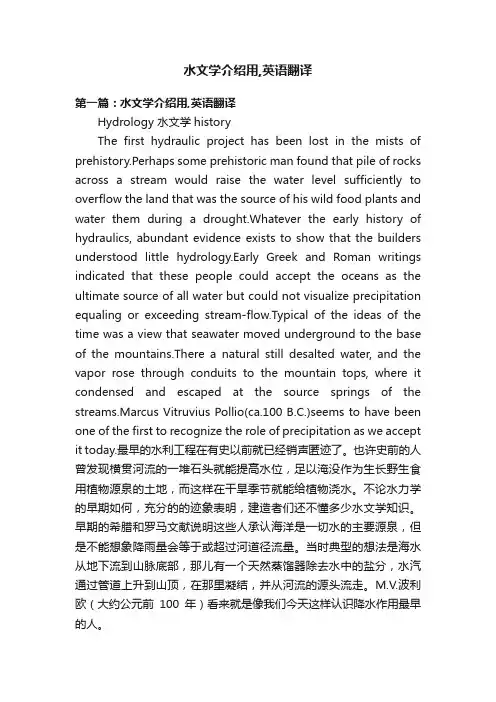
水文学介绍用,英语翻译第一篇:水文学介绍用,英语翻译Hydrology 水文学historyThe first hydraulic project has been lost in the mists of prehistory.Perhaps some prehistoric man found that pile of rocks across a stream would raise the water level sufficiently to overflow the land that was the source of his wild food plants and water them during a drought.Whatever the early history of hydraulics, abundant evidence exists to show that the builders understood little hydrology.Early Greek and Roman writings indicated that these people could accept the oceans as the ultimate source of all water but could not visualize precipitation equaling or exceeding stream-flow.Typical of the ideas of the time was a view that seawater moved underground to the base of the mountains.There a natural still desalted water, and the vapor rose through conduits to the mountain tops, where it condensed and escaped at the source springs of the streams.Marcus Vitruvius Pollio(ca.100 B.C.)seems to have been one of the first to recognize the role of precipitation as we accept it today.最早的水利工程在有史以前就已经销声匿迹了。
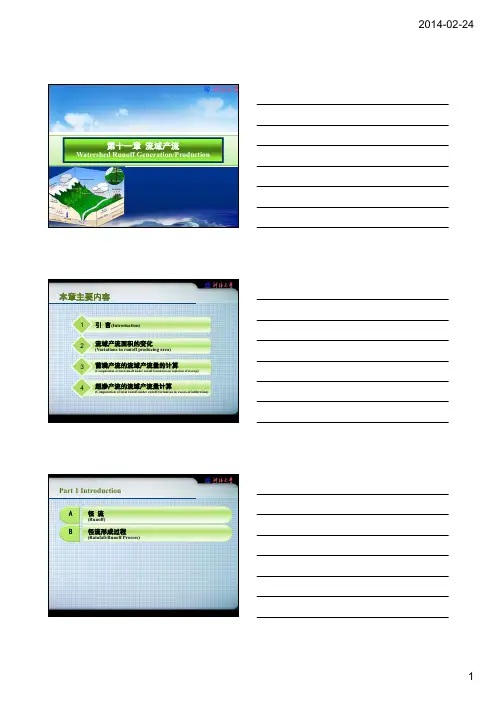
第十一章流域产流Watershed Runoff Generation/Production本章主要内容1引言(Introduction)流域产流面积的变化2(Variations in runoff producing area)蓄满产流的流域产流量的计算3(Computation of total runoff under runoff formation on repletion of storage)超渗产流的流域产流量计算4(Computation of total runoff under runoff formation in excess of infiltration)Part 1 IntroductionA径流(Runoff)B径流形成过程(Rainfall-Runoff Process)Part 1 Introduction1-1 Runoff降落在流域上的具有一定时空分布的降水,扣除损失后,在重力作用下,从地面和地下向流域出口断面汇集的水流现象称径流。
1) Definition(定义)Part 1 Introduction1-1 Runoff降水-径流过程中最根本的损失即蒸散发降落在流域上的具有一定时空分布的降水,扣除损失后,在重力作用下,从地面和地下向流域出口断面汇集的水流现象称径流。
1) Definition(定义)蒸散发土壤持水耗于蒸散发填洼耗于蒸发或继续下渗截留耗于蒸散发或下渗损失Part 1 Introduction1-1 Runoff2) 径流量降水量扣除损失量余额称为径流量,又称净雨量。
径流量的单位:体积单位(m 3, 万m 3, 亿m 3), 谈水资源量时常用m 3径流深(Runoff Depth)单位:长度单位(mm), 分析降雨径流关系时用mm3) 径流量的时程分配(Temporal distribution of runoff)降水的时程分配扣除损失量的时程分配之结果称为径流量时程分配,又称净雨量的时程分配。
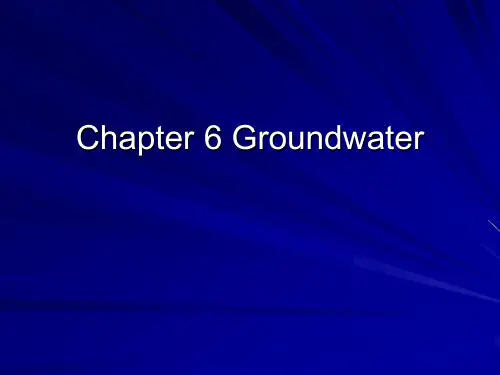
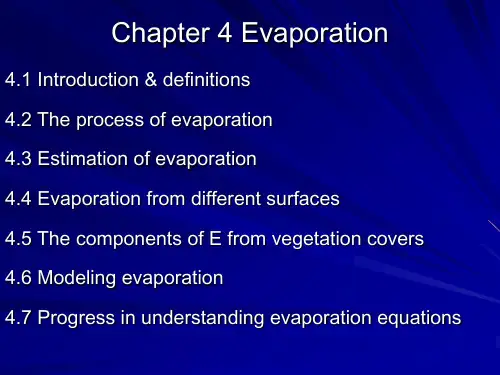

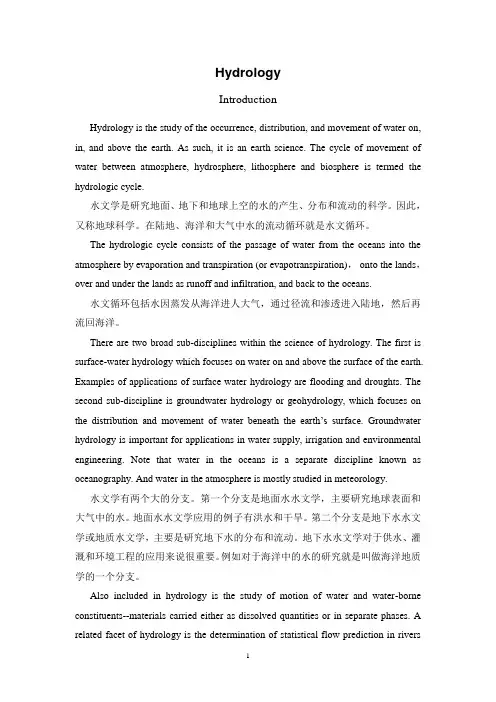
HydrologyIntroductionHydrology is the study of the occurrence, distribution, and movement of water on, in, and above the earth. As such, it is an earth science. The cycle of movement of water between atmosphere, hydrosphere, lithosphere and biosphere is termed the hydrologic cycle.水文学是研究地面、地下和地球上空的水的产生、分布和流动的科学。
因此,又称地球科学。
在陆地、海洋和大气中水的流动循环就是水文循环。
The hydrologic cycle consists of the passage of water from the oceans into the atmosphere by evaporation and transpiration (or evapotranspiration),onto the lands,over and under the lands as runoff and infiltration, and back to the oceans.水文循环包括水因蒸发从海洋进人大气,通过径流和渗透进入陆地,然后再流回海洋。
There are two broad sub-disciplines within the science of hydrology. The first is surface-water hydrology which focuses on water on and above the surface of the earth. Examples of applications of surface water hydrology are flooding and droughts. The second sub-discipline is groundwater hydrology or geohydrology, which focuses on the distribution and movement of water beneath the earth’s surface. Groundwater hydrology is important for applications in water supply, irrigation and environmental engineering. Note that water in the oceans is a separate discipline known as oceanography. And water in the atmosphere is mostly studied in meteorology.水文学有两个大的分支。
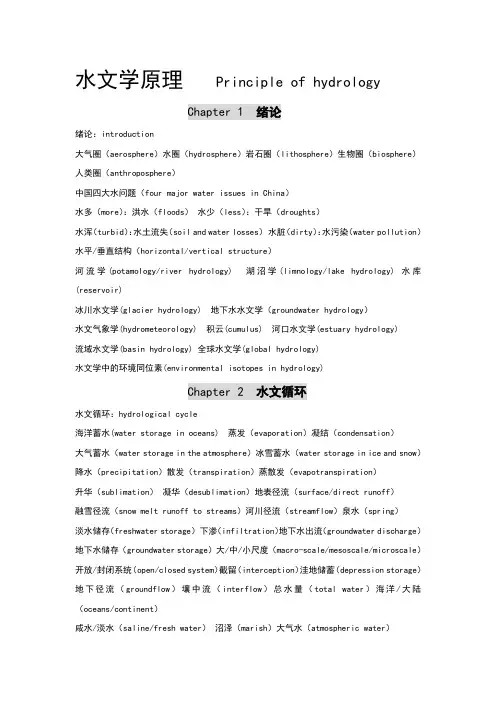
水文学原理Principle of hydrologyChapter 1 绪论绪论:introduction大气圈(aerosphere)水圈(hydrosphere)岩石圈(lithosphere)生物圈(biosphere)人类圈(anthroposphere)中国四大水问题(four major water issues in China)水多(more):洪水(floods)水少(less):干旱(droughts)水浑(turbid):水土流失(soil and water losses)水脏(dirty):水污染(water pollution)水平/垂直结构(horizontal/vertical structure)河流学(potamology/river hydrology) 湖沼学(limnology/lake hydrology) 水库(reservoir)冰川水文学(glacier hydrology) 地下水水文学(groundwater hydrology)水文气象学(hydrometeorology) 积云(cumulus) 河口水文学(estuary hydrology)流域水文学(basin hydrology) 全球水文学(global hydrology)水文学中的环境同位素(environmental isotopes in hydrology)Chapter 2 水文循环水文循环:hydrological cycle海洋蓄水(water storage in oceans) 蒸发(evaporation)凝结(condensation)大气蓄水(water storage in the atmosphere)冰雪蓄水(water storage in ice and snow)降水(precipitation)散发(transpiration)蒸散发(evapotranspiration)升华(sublimation)凝华(desublimation)地表径流(surface/direct runoff)融雪径流(snow melt runoff to streams)河川径流(streamflow)泉水(spring)淡水储存(freshwater storage)下渗(infiltration)地下水出流(groundwater discharge)地下水储存(groundwater storage)大/中/小尺度(macro-scale/mesoscale/microscale)开放/封闭系统(open/closed system)截留(interception)洼地储蓄(depression storage)地下径流(groundflow)壤中流(interflow)总水量(total water)海洋/大陆(oceans/continent)咸水/淡水(saline/fresh water)沼泽(marish)大气水(atmospheric water)生物水(biological water)土壤水(soil water)Chapter 3 流域与水系流域与水系:Watershed & Drainage NetworksPart 1 基本概念分水线(watershed divide) 闭合流域(closed watershed)非闭合流域(unclosed watershed) 水系(Drainage Networks)羽毛状水系(Elongated shape) 平行状水系(fan shape)混合状水系(mixed shape) 坡地(Slope) 倾斜面(inclined plane)收敛曲面(Convergent Camber) 发散曲面(Divergent Camber流域基本单元(Unit)P art 2 水系的地貌特征河源 (headwater) 节点 (node) 出口 (outlet)外链 (External links) 内链 (Internal links) 干流(main river)支流(tributary river) Strahler分级法河流长度(stream length)河数定律(the law of stream numbers) 河长定律(the law of stream lengths)链长度(Link Length) 横断面(Cross section) 纵断面(longitudinal section)大断面(flood cross-section) 弯曲率(Sinuosity)河底比降(Slope of stream bed)Part 3 流域的地貌特征流域形状(Shape of watershed)流域坡度(Slope of watershed)流域面积及面积定律(Drainage area and the law of drainage areas)流域长度和宽度(Width and length of watershed)形态因子(Shape factor)圆度(Circularity ratio) 伸长比(Elongation ratio)河网密度和河道维持常数(Drainage density & constant of channel maintenance)河流频度和链频度 (Stream frequency & link frequency)面积--河长曲线(Drainage area-stream length curve )高程曲线(Elevation curve)Chapter 4 降水降水 (Precipitation)Part 1 降水要素及其时空变化表示方法(Precipitation elements & Temporal and spatial variation)降雨的基本要素(Rainfall Elements)降雨量(深) Rainfall (depth)降雨历时(Rainfall duration) 降雨强度(Rainfall intensity) 降雨面积(Rainfall area) 暴雨中心(Storm center)降雨强度与历时曲线(Rainfall intensity-duration curve)降雨深与面积关系曲线(Rainfall depth-area curve)降雨深与面积和历时关系曲线(Rainfall depth-area-duration curve)Part 2 降雨类型及其影响因素(Types of rainfall and Affecting factors)气旋雨(Cyclonic rain) 对流雨(Convectional/Convectiverain)台风雨(Typhoons/Hurricanes) 地形雨(Orographic rain)锋面雨(Frontal rain) 非锋面雨(Non-frontal rain)Part 3 区域(流域)平均降雨量计算方法(Calculation method of Average rainfall overan area)算术平均法 (Arithmetic mean method) 泰森多边形法 (Thiessen polygon method)等雨量线法 (Isohyetal method) 距离平方倒数法(Inverse distance-squared method)雷达测雨 (Radar measurement of rainfall) 卫星测雨 (Satellitic measurementof rainfall)Part4 降雨资料的检验(Test of rainfall data)Chapter 5 土壤水土壤水(Soil Water)水文循环(Hydrologic Cycle)土壤颗粒(soil particles)过滤(leach)蒸发(evaporation)蒸发,散发(transpiration)水分(moisture)Part 1土壤的质地结构及“三相”关系土壤质地 (Soil texture) 粘粒(clay)粉粒(silt)砂粒(sand)土壤结构 (Soil configuration) 土壤中的“三相”关系 (Three phases within a soil)固体(Solids)液体(Liquids)空气(Vapor)固体密度(solid density) 干容重(Dry bulk density) 孔隙度(Porosity)质量含水率(Gravimetric water content) 容积含水率(volumetric water content)饱和度(the degree of saturation) 充气孔隙度(Aeration porosity)孔隙比(Void ratio)Part 2土壤水的存在形态土壤水作用力(Forces governing soil water) 分子力(Molecular force)毛管力(Capillary force) 粘着力(Adhesion)粘结力(Cohesion)重力(Gravitational force) 土壤水类型 (Soil waterclassification)束缚水(bound water)吸湿水(Hygroscopic Water) 膜状水(Film water)毛管上升水(Ascending water in capillary tube) 渗透重力水(percolating water)毛管悬着水(Suspended capillary water) sustained gravitational water(支持重力水)土壤水分常数 (Soil water constants) 田间持水量(field capacity)Saturation(饱和状态)Part 3土壤水的能量状态土水势 (Soil water potential) 影响因素(Affect the factors)土壤水分特性曲线 (Soil water characteristic curve)Chapter 6 下渗下渗: InfiltrationPart 1 引言(Introduction)土壤水分剖面 (soil moisture profile) 下渗 (infiltration)下渗率(infiltration intensity) 下渗容量(infiltration capacity)下渗曲线(infiltration capacity curve)累积下渗曲线(accumulative infiltration capacity curve)下渗机理(mechanism of infiltration)Part 2 非饱和下渗理论()下渗方程的导出(deduction of infiltration equation)忽略重力作用的下渗方程的解(solution under gravity neglected)完全下渗方程的解(solution under whole condition)Part 3饱和下渗理论()基本方程的建立 establishment of basic equation下渗曲线的导出(deduction of infiltration curve)Chapter 7 蒸发与散发蒸发与散发(Evaporation & Transpiration)Part 1蒸发现象及其控制条件(evaporation and control conditions)基本概念(basic concepts)蒸发潜热 (heat of vaporization)蒸发率(evaporation rate) 凝结潜热 (condensation latent)蒸发能力(evaporation capacity) 蒸发分类 classification of evaporation控制蒸发率的条件 controlling conditions for evaporation 动力条件(dynamic)气象条件meteorological condition 供水条件 (water supply)Part 2 水面蒸发(water surface evaporation)太阳辐射 (solar radiation) 气压 (air pressure) 风速 (wind velocity)温度 (temperature) 湿度 (humidity) 水面大小(water surface area)水面形状(shape of water body) 水深 (water depth) 水质(water quality)理论方法(theoretical method)热量平衡法 (heat balance method)空气动力学法 (aerodynamic method) 混合法 (mixed method)水量平衡法 (water balance method) 经验公式(empirical equation)器测法( instrument-measurement method )水面蒸发的时空分布特点 temporal spatial distribution characteristicsPart 3 土壤蒸发土壤蒸发过程 (soil water evaporation processes)土壤蒸发规律 (soil water evaporation rules)Part 4 植物散发散发现象(phenomena of plant transpiration) 植物散发规律(plant transpiration rules)植物散发的确定 (determination of transpiration)Part 5 流域蒸散发(watershed evapotranspiration)上层(Upper Layer)下层(Lower Layer)深层(Deep Layer)Chapter 8 产流机制产流机制:mechanism of runoff generation径流 (Runoff) 径流形成过程 (Rainfall-Runoff Process)径流深(Runoff Depth) 径流量的时程分配(Temporal distribution of runoff)Part 1包气带及其结构(Aeration (vadose) zone and its structure)包气带和饱水带(aeration zone or vadose zone and Saturdayed zone)特殊包气带(Special aeration zone)三相系统(three-phase system(liquid, gaseous,solid))土壤结构(soil structure)包气带结构(The structure of aeration zone)高寒地带的包气带(aeration zone in a high and cold area)Part 2包气带的水分动态及对降雨的再分配作用(Soil moisture dynamics in aeration zone and its roles in partitioning rainfall)A、包气带水分动态(soil moisture dynamics in aeration zone)包气带水分的增长(Soil moisture increase in aeration zone)包气带水分的消退(Recession of soil moisture in aeration zone)B、包气带对降雨的再分配作用(The role of aeration zone in redistributing rainfall)筛子(sieve)门槛(threshold)C、包气带水量平衡方程式(Water balance equation for aeration zone)Part 3 产流的物理条件(Physical conditions for runoff generation)超渗地面径流(Hortonian overland flow) (Rainfall excess)壤中水径流产流(through flow / subsurface flow / interflow)饱和地面径流条件(saturated overland flow)回归流(return flow)Part 4 基本产流模式 (Basic modes of runoff generation)Chapter 9 地表水流地表水流:surface flowPart 1 洪水波的形成及传播(Formation and propagation of flood wave) A、洪水波运动 (movement wave)a、几何特征(geomtric characteristics)波体(main body of flood wave)波高(wave height)波长(wave length)b、附加比降(additional slope)c、相应流量与相应水位(Corresponding discharge (water levels, stages) )d、波速(wave velocity)e、坦化(attenuation)扭曲(distortion)B、洪水运动的水力学描述(Hydraulic description of flood wave movement)圣维南方程组(Saint-Venant Equations)连续方程(Continuity equation or mass conservation equation)动力方程 (Momentum equation)C、洪水波的分类(Classification of flood wave)空间惯性迁移惯性项(convective inertia term)重力(gravity)时间惯性力局地惯性项(local inertia term)压力(pressure )阻力(friction)D、运动波 (Kinematic wave)E、扩散波 (Diffusion wave)Part 2(Storage theory & storage equation)A、河槽调节作用和河段水量平衡方程(Storage effects of a river channel and waterbalance equation for a reach)蓄满产流(Runoff generation on repletion of storage)超渗产流(Runoff generation in excess of infiltration)B、槽蓄方程(Storage equation)C、洪水波运动的水文学方法(Hydrological method of flood wave movementD 、特征河长(Characteristic river length)F、槽蓄曲线的特性(Nature of Storage-discharge curve)Chapter 10 洪水演算洪水演算 (Flood Routing)Part 1 引言 (Introduction)具有物理基础的洪水演算法 (Physically-based flood routing method)质量守恒(mass conservation)动量守恒(momentum conservation)Part 2 线性扩散波演算法(Linear diffusion wave routing method)定解问题的构成 (Composition of solution problems) 基本解 (Basic solution)出流过程的计算(Derivation of outflow hydrograph) 扩散波(Diffusion wave)入流过程 (Processing of inflow hydrograph) 稳定流(Steady flow)参数的确定 (Determination of parameters) 卷积公式(Convolution formula)上断面洪水过程(inflow hydrograph at upper section)半无限长,自由下边界(semi—infinite long, free lower boundary)简单入流过程(Simple inflow hydrograph) 单位入流过程(Unit Inflow hydrograph)单位矩形入流过程 (Unit Rectangular Pulse Input)单位瞬时脉冲入流(Unit instantaneous Pulse Input)入流过程离散化(Discretizing inflow hydrograph) 汇流曲线(flow concentration curve)Part 3 线性特征河长演算法(Linear characteristic length routing method)描述洪水波运动的基本微分方程式(Basic differential equations of flood wave movement)汇流曲线的确定(Determination of flow concentration curve)Part 4 线性运动波演算法(Linear kinematic wave routing method)运动波差分方程的建立(Difference equation of kinematic wave)数值扩散的概念(Numerical diffusion) 连续演算问题(successive routing)汇流系数的计算(Calculation of flow concentration coefficient)泰勒公式(Taylor formula) 汇流系数(flow concentrationcoefficient)Chapter 11 流域产流流域产流:Watershed Runoff Generation/ProductionPart 1 引言(Introduction)径流 (Runoff) 径流形成过程 (Rainfall-Runoff Process)径流深(Runoff Depth) 径流量的时程分配(Temporal distribution of runoff) Part 2流域产流面积的变化(Variations in runoff producing area)A、现象及原因(Phenomena & Causes)蓄满产流(Runoff generation on repletion of storage)超渗产流(Runoff generation in excess of infiltration)B、蓄满产流条件下总径流的产流面积变化(Variations in the runoff producing area of total runoff under runoff formation on repletion of storage)蓄水容量曲线(Watershed Capacity Curve)流域蓄水容量曲线(Watershed water capacity curve)在降雨空间分布均匀的情况下(Spatial distribution of rainfall is even) C、超渗产流地面径流产流面积变化(Variations in the runoff producing area of surface runoff under runoff formation in excess of infiltration)Part 3 蓄满产流的流域产流量的计算(Computation of total runoff under runoff formation on repletion of storage)总径流量的计算(Computation of total runoff)径流成分的划分(Separation of runoff components)降雨空间分布不均匀情况(Spatial distribution of rainfall being uneven)Part 4超渗产流的流域产流量计算(Computation of total runoff under runoff formation in excess of infiltration)Chapter 12 流域汇流流域汇流:Watershed flow concentrationPart 1 基本概念及数学描述Basic Concepts and mathematical description A、流域汇流的路径Watershed flow paths几何路径 (Geometric paths) 状态路径 (State paths)B、流域汇流时间Watershed flow time of concentration平均流域汇流时间 (Average watershed flow time of concentration)最大流域汇流时间 (Maximum Watershed flow time of concentration)C、径流成因公式Formula for computing the discharge at the watershed outletD、流域调蓄作用Watershed storage effectsPart 2流域汇流系统分析 Analysis of watershed flow concentration system 基于流域调蓄作用的流域汇流系统的数学表达式(Mathematical description of storage-effect-based watershed flow system)流域瞬时单位线(Watershed Instantaneous Unit Hydrograph)卷积公式 (Convolution formula)流域单位线的识别(Determination of unit hydrograph)Part 3面积—时间曲线Time-area histogram等流时线和等流时面积(Isochrones and Inter-isochrone areas)等流时线法(Isochrones Method)Part 4概念性流域汇流模型Conceptual watershed flow concentration models 概念性元件(Conceptual components)“渠道”型 (Canal type) b. “水库”型(Reservoir type)概念性元件的组合及其瞬时单位线(Combination of conceptual components and the corresponding instantaneous unit hydrograph)。
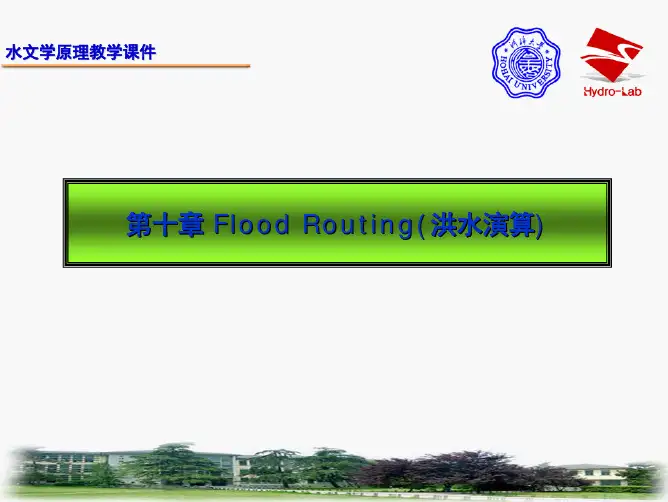
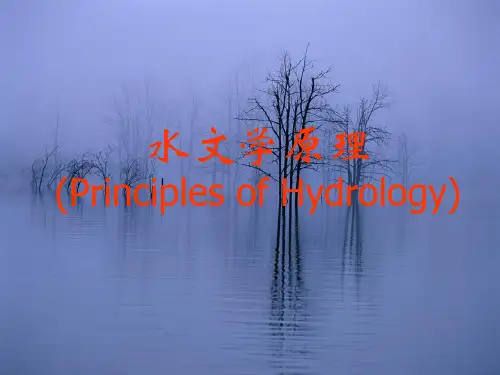
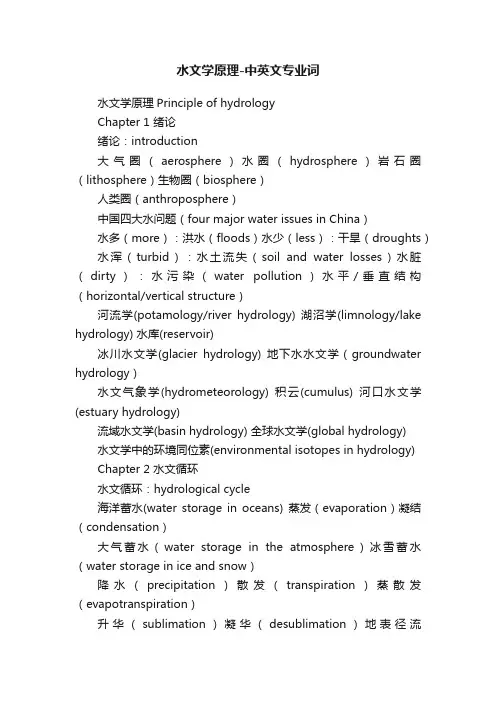
水文学原理-中英文专业词水文学原理Principle of hydrologyChapter 1 绪论绪论:introduction大气圈(aerosphere)水圈(hydrosphere)岩石圈(lithosphere)生物圈(biosphere)人类圈(anthroposphere)中国四大水问题(four major water issues in China)水多(more):洪水(floods)水少(less):干旱(droughts)水浑(turbid):水土流失(soil and water losses)水脏(dirty):水污染(water pollution)水平/垂直结构(horizontal/vertical structure)河流学(potamology/river hydrology) 湖沼学(limnology/lake hydrology) 水库(reservoir)冰川水文学(glacier hydrology) 地下水水文学(groundwater hydrology)水文气象学(hydrometeorology) 积云(cumulus) 河口水文学(estuary hydrology)流域水文学(basin hydrology) 全球水文学(global hydrology)水文学中的环境同位素(environmental isotopes in hydrology)Chapter 2 水文循环水文循环:hydrological cycle海洋蓄水(water storage in oceans) 蒸发(evaporation)凝结(condensation)大气蓄水(water storage in the atmosphere)冰雪蓄水(water storage in ice and snow)降水(precipitation)散发(transpiration)蒸散发(evapotranspiration)升华(sublimation)凝华(desublimation)地表径流(surface/direct runoff)融雪径流(snow melt runoff to streams)河川径流(streamflow)泉水(spring)淡水储存(freshwater storage)下渗(infiltration)地下水出流(groundwater discharge)地下水储存(groundwater storage)大/中/小尺度(macro-scale/mesoscale/microscale)开放/封闭系统(open/closed system)截留(interception)洼地储蓄(depression storage)地下径流(groundflow)壤中流(interflow)总水量(total water)海洋/大陆(oceans/continent)咸水/淡水(saline/fresh water)沼泽(marish)大气水(atmospheric water)生物水(biological water)土壤水(soil water)Chapter 3 流域与水系流域与水系:Watershed & Drainage NetworksPart 1 基本概念分水线(watershed divide) 闭合流域(closed watershed)非闭合流域(unclosed watershed) 水系(Drainage Networks)羽毛状水系(Elongated shape) 平行状水系(fan shape)混合状水系(mixed shape) 坡地(Slope) 倾斜面(inclined plane) 收敛曲面(Convergent Camber) 发散曲面(Divergent Camber 流域基本单元(Unit)P art 2 水系的地貌特征河源(headwater) 节点(node) 出口(outlet)外链(External links) 内链(Internal links) 干流(main river)支流(tributary river) Strahler分级法河流长度(stream length) 河数定律(the law of stream numbers) 河长定律(the law of stream lengths) 链长度(Link Length) 横断面(Cross section) 纵断面(longitudinal section)大断面(flood cross-section) 弯曲率(Sinuosity)河底比降(Slope of stream bed)Part 3 流域的地貌特征流域形状(Shape of watershed)流域坡度(Slope of watershed)流域面积及面积定律(Drainage area and the law of drainage areas)流域长度和宽度(Width and length of watershed)形态因子(Shape factor)圆度(Circularity ratio) 伸长比(Elongation ratio)河网密度和河道维持常数(Drainage density & constant of channel maintenance)河流频度和链频度(Stream frequency & link frequency)面积--河长曲线(Drainage area-stream length curve )高程曲线(Elevation curve)Chapter 4 降水降水(Precipitation)Part 1 降水要素及其时空变化表示方法(Precipitation elements & Temporal and spatial variation)降雨的基本要素(Rainfall Elements)降雨量(深) Rainfall (depth)降雨历时(Rainfall duration) 降雨强度(Rainfall intensity)降雨面积(Rainfall area) 暴雨中心(Storm center)降雨强度与历时曲线(Rainfall intensity-duration curve)降雨深与面积关系曲线(Rainfall depth-area curve)降雨深与面积和历时关系曲线(Rainfall depth-area-duration curve)Part 2 降雨类型及其影响因素(Types of rainfall and Affecting factors)气旋雨(Cyclonic rain) 对流雨(Convectional/Convective rain) 台风雨(Typhoons/Hurricanes) 地形雨(Orographic rain)锋面雨(Frontal rain) 非锋面雨(Non-frontal rain)Part 3 区域(流域)平均降雨量计算方法(Calculation method of Average rainfall over an area)算术平均法(Arithmetic mean method) 泰森多边形法(Thiessen polygon method) 等雨量线法(Isohyetal method) 距离平方倒数法(Inverse distance-squared method) 雷达测雨(Radar measurement of rainfall) 卫星测雨(Satellitic measurement of rainfall) Part4 降雨资料的检验(Test of rainfall data)Chapter 5 土壤水土壤水(Soil Water)水文循环(Hydrologic Cycle)土壤颗粒(soil particles)过滤(leach)蒸发(evaporation)蒸发,散发(transpiration)水分(moisture)Part 1土壤的质地结构及“三相”关系土壤质地(Soil texture) 粘粒(clay)粉粒(silt)砂粒(sand)土壤结构(Soil configuration) 土壤中的“三相”关系(Three phases within a soil) 固体(Solids)液体(Liquids)空气(Vapor)固体密度(solid density) 干容重(Dry bulk density) 孔隙度(Porosity)质量含水率(Gravimetric water content) 容积含水率(volumetric water content)饱和度(the degree of saturation) 充气孔隙度(Aeration porosity) 孔隙比(V oid ratio)Part 2土壤水的存在形态土壤水作用力(Forces governing soil water) 分子力(Molecular force) 毛管力(Capillary force) 粘着力(Adhesion)粘结力(Cohesion)重力(Gravitational force) 土壤水类型(Soil water classification) 束缚水(bound water)吸湿水(Hygroscopic Water) 膜状水(Film water) 毛管上升水(Ascending water in capillary tube) 渗透重力水(percolating water)毛管悬着水(Suspended capillary water) sustained gravitational water(支持重力水) 土壤水分常数(Soil water constants) 田间持水量(field capacity)Saturation(饱和状态)Part 3土壤水的能量状态土水势(Soil water potential) 影响因素(Affect the factors)土壤水分特性曲线(Soil water characteristic curve)Chapter 6 下渗下渗: InfiltrationPart 1 引言(Introduction)土壤水分剖面(soil moisture profile) 下渗(infiltration)下渗率(infiltration intensity) 下渗容量(infiltration capacity)下渗曲线(infiltration capacity curve)累积下渗曲线(accumulative infiltration capacity curve)下渗机理(mechanism of infiltration)Part 2 非饱和下渗理论()下渗方程的导出(deduction of infiltration equation)忽略重力作用的下渗方程的解(solution under gravity neglected)完全下渗方程的解(solution under whole condition)Part 3饱和下渗理论()基本方程的建立establishment of basic equation下渗曲线的导出(deduction of infiltration curve)Chapter 7 蒸发与散发蒸发与散发(Evaporation & Transpiration)Part 1蒸发现象及其控制条件(evaporation and control conditions)基本概念(basic concepts)蒸发潜热(heat of vaporization) 蒸发率(evaporation rate) 凝结潜热(condensation latent) 蒸发能力(evaporation capacity) 蒸发分类classification of evaporation 控制蒸发率的条件controlling conditions for evaporation 动力条件(dynamic) 气象条件meteorological condition 供水条件(water supply) Part 2 水面蒸发(water surface evaporation)太阳辐射(solar radiation) 气压(air pressure) 风速(wind velocity)温度(temperature) 湿度(humidity) 水面大小(water surface area) 水面形状(shape of water body) 水深(water depth) 水质(water quality) 理论方法(theoretical method)热量平衡法(heat balance method) 空气动力学法(aerodynamic method) 混合法(mixed method) 水量平衡法(water balance method) 经验公式(empirical equation)器测法(instrument-measurement method )水面蒸发的时空分布特点temporal spatial distribution characteristicsPart 3 土壤蒸发土壤蒸发过程(soil water evaporation processes)土壤蒸发规律(soil water evaporation rules)Part 4 植物散发散发现象(phenomena of plant transpiration) 植物散发规律(plant transpiration rules) 植物散发的确定(determination of transpiration)Part 5 流域蒸散发(watershed evapotranspiration)上层(Upper Layer)下层(Lower Layer)深层(Deep Layer)Chapter 8 产流机制产流机制:mechanism of runoff generation径流(Runoff) 径流形成过程(Rainfall-Runoff Process)径流深(Runoff Depth) 径流量的时程分配(Temporal distribution of runoff)Part 1包气带及其结构(Aeration (vadose) zone and its structure)包气带和饱水带(aeration zone or vadose zone and Saturdayed zone)特殊包气带(Special aeration zone)三相系统(three-phase system(liquid,gaseous,solid))土壤结构(soil structure)包气带结构(The structure of aeration zone)高寒地带的包气带(aeration zone in a high and cold area)Part 2包气带的水分动态及对降雨的再分配作用(Soil moisture dynamics in aeration zone and its roles in partitioning rainfall)A、包气带水分动态(soil moisture dynamics in aeration zone)包气带水分的增长(Soil moisture increase in aeration zone)包气带水分的消退(Recession of soil moisture in aeration zone)B、包气带对降雨的再分配作用(The role of aeration zone in redistributing rainfall)筛子(sieve)门槛(threshold)C、包气带水量平衡方程式(Water balance equation for aeration zone)Part 3 产流的物理条件(Physical conditions for runoff generation)超渗地面径流(Hortonian overland flow)(Rainfall excess)壤中水径流产流(through flow / subsurface flow / interflow)饱和地面径流条件(saturated overland flow)回归流(return flow)Part 4 基本产流模式(Basic modes of runoff generation)Chapter 9 地表水流地表水流:surface flowPart 1 洪水波的形成及传播(Formation and propagation of flood wave)A、洪水波运动(movement wave)a、几何特征(geomtric characteristics)波体(main body of flood wave)波高(wave height)波长(wave length)b、附加比降(additional slope)c、相应流量与相应水位(Corresponding discharge (water levels, stages) )d、波速(wave velocity)e、坦化(attenuation)扭曲(distortion)B、洪水运动的水力学描述(Hydraulic description of flood wave movement)圣维南方程组(Saint-Venant Equations)连续方程(Continuity equation or mass conservation equation) 动力方程(Momentum equation)C、洪水波的分类(Classification of flood wave)空间惯性迁移惯性项(convective inertia term)重力(gravity)时间惯性力局地惯性项(local inertia term)压力(pressure )阻力(friction)D、运动波(Kinematic wave)E、扩散波(Diffusion wave)Part 2(Storage theory & storage equation)A、河槽调节作用和河段水量平衡方程(Storage effects of a river channel and water balanceequation for a reach)蓄满产流(Runoff generation on repletion of storage)超渗产流(Runoff generation in excess of infiltration)B、槽蓄方程(Storage equation)C、洪水波运动的水文学方法(Hydrological method of flood wave movementD 、特征河长(Characteristic river length)F、槽蓄曲线的特性(Nature of Storage-discharge curve)Chapter 10 洪水演算洪水演算(Flood Routing)Part 1 引言(Introduction)具有物理基础的洪水演算法(Physically-based flood routing method)质量守恒(mass conservation)动量守恒(momentum conservation)Part 2 线性扩散波演算法(Linear diffusion waverouting method)定解问题的构成(Composition of solution problems) 基本解(Basic solution) 出流过程的计算(Derivation of outflow hydrograph) 扩散波(Diffusion wave)入流过程(Processing of inflow hydrograph) 稳定流(Steady flow)参数的确定(Determination of parameters) 卷积公式(Convolution formula)上断面洪水过程(inflow hydrograph at upper section)半无限长,自由下边界(semi—infinite long, free lower boundary)简单入流过程(Simple inflow hydrograph) 单位入流过程(Unit Inflow hydrograph) 单位矩形入流过程(Unit Rectangular Pulse Input)单位瞬时脉冲入流(Unit instantaneous Pulse Input)入流过程离散化(Discretizing inflow hydrograph) 汇流曲线(flow concentration curve) Part 3 线性特征河长演算法(Linear characteristic length routing method) 描述洪水波运动的基本微分方程式(Basic differential equations of flood wave movement) 汇流曲线的确定(Determination of flow concentration curve) Part 4 线性运动波演算法(Linear kinematic wave routing method)运动波差分方程的建立(Difference equation of kinematic wave) 数值扩散的概念(Numerical diffusion) 连续演算问题(successive routing) 汇流系数的计算(Calculation of flow concentration coefficient)泰勒公式(Taylor formula) 汇流系数(flow concentration coefficient)Chapter 11 流域产流流域产流:Watershed Runoff Generation/ProductionPart 1 引言(Introduction)径流(Runoff) 径流形成过程(Rainfall-Runoff Process)径流深(Runoff Depth) 径流量的时程分配(Temporal distribution of runoff)Part 2流域产流面积的变化(Variations in runoff producing area)A、现象及原因(Phenomena & Causes)蓄满产流(Runoff generation on repletion of storage)超渗产流(Runoff generation in excess of infiltration)B、蓄满产流条件下总径流的产流面积变化(Variations in the runoff producing area of total runoff under runoff formation on repletion of storage)蓄水容量曲线(Watershed Capacity Curve)流域蓄水容量曲线(Watershed water capacity curve)在降雨空间分布均匀的情况下(Spatial distribution of rainfall is even)C、超渗产流地面径流产流面积变化(Variations in the runoff producing area of surface runoff under runoff formation in excess of infiltration)Part 3 蓄满产流的流域产流量的计算(Computation of total runoff under runoff formation on repletion of storage)总径流量的计算(Computation of total runoff)径流成分的划分(Separation of runoff components)降雨空间分布不均匀情况(Spatial distribution of rainfall being uneven)Part 4超渗产流的流域产流量计算(Computation of total runoff under runoff formation in excess of infiltration)Chapter 12 流域汇流流域汇流:Watershed flow concentrationPart 1 基本概念及数学描述Basic Concepts and mathematical descriptionA、流域汇流的路径Watershed flow paths几何路径(Geometric paths) 状态路径(State paths)B、流域汇流时间Watershed flow time of concentration平均流域汇流时间(Average watershed flow time of concentration)最大流域汇流时间(Maximum Watershed flow time of concentration)C、径流成因公式Formula for computing the discharge at the watershed outletD、流域调蓄作用Watershed storage effectsPart 2流域汇流系统分析Analysis of watershed flow concentration system 基于流域调蓄作用的流域汇流系统的数学表达式(Mathematical description of storage-effect-based watershed flow system)流域瞬时单位线(Watershed Instantaneous Unit Hydrograph) 卷积公式(Convolution formula)流域单位线的识别(Determination of unit hydrograph)Part 3面积—时间曲线Time-area histogram等流时线和等流时面积(Isochrones and Inter-isochrone areas) 等流时线法(Isochrones Method)Part 4概念性流域汇流模型Conceptual watershed flow concentration models 概念性元件(Conceptual components) “渠道”型(Canal type) b. “水库”型(Reservoir type)概念性元件的组合及其瞬时单位线(Combination of conceptual components and the corresponding instantaneous unit hydrograph)。
第三章流域及水系(River basin & river system)本章主要内容基本概念1水系地貌特征2流域地貌特征3数字高程模型及流域特征的提取41.分水线-§1 基本概念山峰、山脊和鞍部的连线集水线地面分水线地形等高线中的极大值称为山峰山峰的下坡方向称为山脊相邻山峰之间的区域称为鞍部地下分水线§1 基本概念2.流域(River basin)指地面分水线包围的、能够汇集雨水从其出口流出的区域。
流域面积(Drainage area)指地面分水线包围区域的水平投影面积。
闭合流域非闭合流域地面分水线与地下分水线重合,且河槽切割至不透水基岩的流域称为闭合流域。
地面分水线与地下分水线不重合或河槽切割不能到达不透水基岩的流域为非闭合流域。
§1 基本概念3.水系流域中大小河流交汇所形成的网络结构,叫做水系,又称河网或河系。
(a)树状结构(b)网状结构水系结构树状结构种类羽毛状结构扇形状结构混合状结构流域面积和降雨时空分布相同情况下水系形状与洪水过程的关系图Q1(t):羽毛状水系洪水过程;Q2(t):扇形状水系洪水过程;Q1(t):混合状水系洪水过程。
4.坡面流域内除河系以外的部分。
坡面的几何形状(a)矩形坡面(b)收敛型坡面(c)散发型坡面5.流域基本单元一个流域若按内部的分水线又可划分成若干个比较小的流域。
在这些比较小的流域内部,又可以根据其内部分水线分成更小的流域。
这样不断地分下去,最终的结果将是无法再分。
这种无法再分成更小的流域,就叫做流域基本单元。
V形马蹄形流域基本单元§2 水系地貌特征水系的拓扑性质水系的几何特征水系的拓扑性质一个几何图形在连续改变其几何形状时仍能保持不变的一些性质。
内链外链基本术语:①河源:顾名思义,就是一条河流的起始点。
②节点:两条相邻河流的交汇处称为节点。
③出口:出口是输送整个河系总水量和其他物质的地方。
④河链:河源与相邻节点之间的连接的河段,或者相邻两个节点之间的连接河段,或者出口与相邻节点之间的连接河段,称为链。